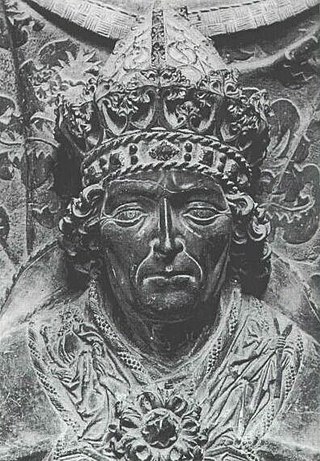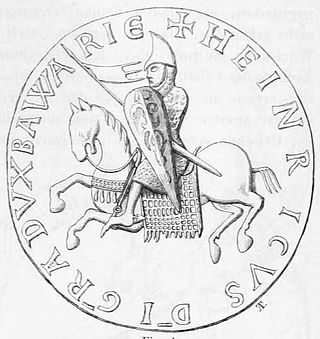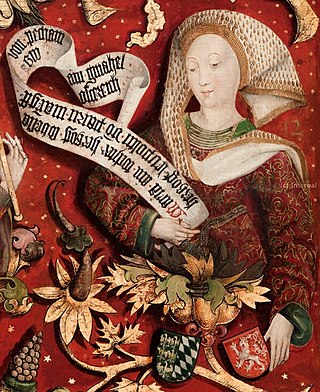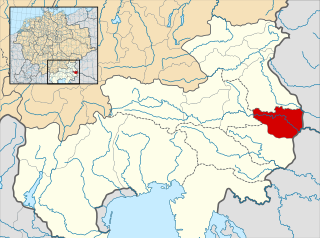Related Research Articles

Louis IV, called the Bavarian, was King of the Romans from 1314, King of Italy from 1327, and Holy Roman Emperor from 1328 until his death in 1347.

The House of Babenberg was a noble dynasty of Austrian Dukes and Margraves. Originally from Bamberg in the Duchy of Franconia, the Babenbergs ruled the imperial Margraviate of Austria from its creation in 976 AD until its elevation to a duchy in 1156, and from then until the extinction of the line in 1246, whereafter they were succeeded by the House of Habsburg, to which they were related.

The Duchy of Carinthia was a duchy located in southern Austria and parts of northern Slovenia. It was separated from the Duchy of Bavaria in 976, and was the first newly created Imperial State after the original German stem duchies.

Leopold I, known as the Illustrious was a member of the House of Babenberg who ruled as Margrave of Austria from 976 until his death. He was the first margrave of the Babenberg dynasty which ruled the March and Duchy of Austria until its extinction in 1246.

Henry II, called Jasomirgott, a member of the House of Babenberg, was Count Palatine of the Rhine from 1140 to 1141, Duke of Bavaria and Margrave of Austria from 1141 to 1156, and the first Duke of Austria from 1156 until his death.

Arnulf II, also known as the Bad, the Evil or the Wicked, a member of the Luitpolding dynasty, held the title of Duke of Bavaria from about 907 until his death in 937. He is numbered in succession to Arnulf of Carinthia, counted as Arnulf I.

Henry I, known as Henry the Strong, was the Margrave of Austria from 994 to his death in 1018. He was a member of the House of Babenberg.
The German name of Austria, Österreich, derives from the Old High German word Ostarrîchi "eastern realm", recorded in the so-called Ostarrîchi Document of 996, applied to the Margraviate of Austria, a march, or borderland, of the Duchy of Bavaria created in 976. The name is seemingly comparable to Austrasia, the early middle age term for the "eastern lands" of Francia, as known from the written records.

The Duchy of Bavaria was a frontier region in the southeastern part of the Merovingian kingdom from the sixth through the eighth century. It was settled by Bavarian tribes and ruled by dukes (duces) under Frankish overlordship. A new duchy was created from this area during the decline of the Carolingian Empire in the late ninth century. It became one of the stem duchies of the East Frankish realm which evolved as the Kingdom of Germany and the Holy Roman Empire.

Gertrude of Süpplingenburg was Duchess of Bavaria, Margravine of Tuscany, and Duchess of Saxony by marriage to Henry X, Duke of Bavaria, and Margravine of Austria and Duchess of Bavaria by marriage to Henry II, Duke of Austria. She was regent of Saxony during the minority of her son Henry the Lion in 1139–1142.

The Duchy of Austria was a medieval principality of the Holy Roman Empire, established in 1156 by the Privilegium Minus, when the Margraviate of Austria (Ostarrîchi) was detached from Bavaria and elevated to a duchy in its own right. After the ruling dukes of the House of Babenberg became extinct in male line, there was as much as three decades of rivalry on inheritance and rulership, until the German king Rudolf I took over the dominion as the first monarch of the Habsburg dynasty in 1276. Thereafter, Austria became the patrimony and ancestral homeland of the dynasty and the nucleus of the Habsburg monarchy. In 1453, the archducal title of the Austrian rulers, invented by Duke Rudolf IV in the forged Privilegium Maius of 1359, was officially acknowledged by the Habsburg emperor Frederick III.

The (Princely) County of Tyrol was an estate of the Holy Roman Empire established about 1140. After 1253, it was ruled by the House of Gorizia and from 1363 by the House of Habsburg. In 1804, the County of Tyrol, unified with the secularised prince-bishoprics of Trent and Brixen, became a crown land of the Austrian Empire. From 1867, it was a Cisleithanian crown land of Austria-Hungary.
The Luitpoldings were a medieval dynasty which ruled the German stem duchy of Bavaria from some time in the late ninth century off and on until 985.

The Saxon Eastern March was a march of the Holy Roman Empire from the 10th until the 12th century. The term "eastern march" stems from the Latin term marchia Orientalis and originally could refer to either a march created on the eastern frontier of the East Frankish duchy of Saxony or another on the eastern border of the Duchy of Bavaria: the Bavarian marchia Orientalis, corresponding to later Austria.

The Margraviate of Austria was a medieval frontier march, centered along the river Danube, between the river Enns and the Vienna Woods, within the territory of modern Austrian provinces of Upper Austria and Lower Austria. It existed from c. 970 to 1156.

The March of Styria, originally known as Carantanian march, was a southeastern frontier march of the Holy Roman Empire. It was broken off the larger March of Carinthia, itself a march of the Duchy of Bavaria, around 970 as a buffer zone against the Hungarian invasions. Under the overlordship of the Carinthian dukes from 976 onwards, the territory evolved to be called Styria, so named for the town of Steyr, then the residence of the Otakar margraves. It became an Imperial State in its own right, when the Otakars were elevated to Dukes of Styria in 1180.

The Duchy of Styria was a duchy located in modern-day southern Austria and northern Slovenia. It was a part of the Holy Roman Empire until its dissolution in 1806 and a Cisleithanian crown land of Austria-Hungary until its dissolution in 1918.

Maria of Bohemia, a member of the Přemyslid dynasty, was Margravine of Austria and Duchess of Bavaria by her first marriage to Duke Leopold I, as well as Margravine of Baden and Verona by her second marriage to Margrave Herman III.
Berthold of Schweinfurt was a German nobleman.

The Mark an der Drau was a historical territory of the Holy Roman Empire and its predecessors during the Middle Ages. It came into being during the second half of the 10th century, covering an area from the eastern border of the Carolingian Carantanian Gaugrafschaft of Jauntal to Pettau in the territory of Friedau (Ormož). After 1147 it was attached to the Mark an der Mur forming the March of Styria/Carantania, which later gave rise to the Duchy of Styria. Other designations for the territory include Mark Pettau, Mark hinter dem Drauwald, Grafschaft hinter dem Drauwald, Marchia transsilvana/transsylvana, Pitouiensis, and untere Karantaner Mark.
References
- ↑ Alois Schmid (Hrsg.): Handbuch der bayerischen Geschichte. Bd. 1: Das Alte Bayern. Teil 1: Von der Vorgeschichte bis zum Hochmittelalter. Verlag C. H. Beck, München 2017, ISBN 978-3-406-68325-1, S. 277f., 286